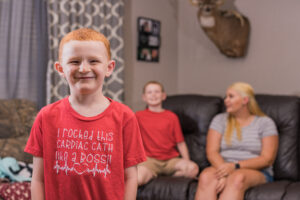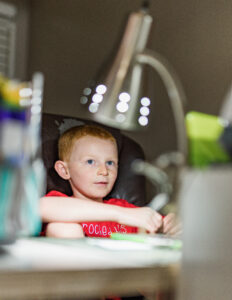Gabe | Living with HCM, MYBPC3 mutation
Okeechobee, FL | Born November, 2014
It’s no secret. He’s going to have a heart transplant someday. It’s just a matter of when. We know it’s coming.
Gabe and Gary chase each other around the house firing small yellow foam balls at each other from their Nerf guns. Gabe sprints down the hallway, pointing back at his older brother and letting off a few blasts before winding around a corner and taking cover. He enters the den and throws himself over the side of the couch to catch his breath. He reaches up to just under his collarbone to rest his hand on a raised area under his skin—something that Gabe calls his “Heart Man.”
Gabe’s Heart Man is always with him, but it never hurts to make sure. Each day he is thankful for the device “I can’t feel the Heart Man most of the time, but I know he’s there.” says Gabe. “He protects my heart, so I don’t pass out forever.” Gabe received his implantable cardioverter defibrillator (ICD) at only one year old, but in the five years since, it has never shocked him. This is good, as the ICD would only go off in order to correct a potentially deadly arrhythmia. However, not a day goes by when he doesn’t think about his Heart Man’s one weakness. “Don’t bring magnets near me or you’ll turn my Heart Man off,” he warns. Gabe doesn’t want to lose the protection it provides and has learned, through experience, what dangers lie in wait if the device were not to work properly. “It’s all okay if I don’t mess with my Heart Man, so he doesn’t take his eye off of me.”
From across the room, Brittni, the boys’ mother, watches the chaos ensue as she calmly sits at the kitchen table, a relatively safe zone, at the moment. She’s decorating a stack of insulated coffee mugs. With glue and bright-red glitter she letters onto the side of each thermos a clear message: “Cardiomyopathy Awareness.” On the other side she places the hashtag #gabestrong. Brittni has been handing out the thermoses all around her hometown of Okeechobee, Florida, to raise awareness about the rare genetic heart disease that her son was born with. “I want to let more people know about cardiomyopathy since I didn’t know anything about it until Gabe was diagnosed.”

Gabe lives with hypertrophic cardiomyopathy (HCM), a genetic condition where his heart muscle fibers become thick and rigid and can limit proper blood flow. The disease is progressive and more common in adults, but the particular severity of Gabe’s HCM is also a direct result of his genetics—he has a double mutation of the MYBPC3 gene, which contains information for cardiac muscle cells. “I have the IVS gene and Gary, my husband, has the ARG gene. Gabe got slammed with both of them, which is why his heart is the way it is.” The double mutation has brought serious risks and complications, requiring specialized care for Gabe since infancy.
There were no prenatal warnings of HCM and Gabe was born without incident. However, at his two-month checkup doctors detected a heart murmur. Their older son had had a similar murmur as an infant, and then grew out of it. Brittni and Gary expected this to also be the case with Gabe, however, when doctors ran an echocardiogram and cardiac MRI, the results were alarming. Gabe’s heart was clearly enlarged in ways it shouldn’t be.
Brittni remembers sitting alone in the office as the doctor delivered the news: her newborn was being diagnosed with HCM. The doctor rattled off a deluge of information about the condition, but Brittni was lost in shock. “I told her, ‘I don’t understand what you’re saying,’” she recalls. “I was like ‘Woah, stop. Slow down. Please dumb it down for me. You’re saying all these medical terms and I have no idea what you’re talking about.’” The encounter left Brittni with confusion and a tinge of disbelief. “It didn’t feel real. I kind of didn’t believe her.” At the end of the appointment, she returned to the waiting area to meet her mother who was watching tiny Gabe. She could barely speak.
Brittni sat in bewildered silence as she drove home glancing back at her baby in his car seat as she pulled into the driveway. Her mother took Gabe into the house, but Brittni stayed quietly behind the wheel. Her eyes were drawn to an angel, sitting innocently on the dashboard. She grabbed the figure and spoke to it. “I said, ‘I don’t know what to do. I don’t know what’s going on. All I know is that I need you with me. I need you to guide me.’” Feeling overwhelmed and lost, she prayed for guidance and assurance that her son would be okay.

After Gabe and his brother tire from their Nerf gun battle, they head to their bedroom to indulge in their favorite pastime: video games. And while the brothers always maintain a healthy sense of competition, some games actually give them ample opportunity to work together. Fortnite and Minecraft, the immensely popular cross-platform games, offer Gabe and Gary a chance to build entire virtual worlds together.
“We build things from here all the way to there” explains Gabe, extending his arms wide to show the scale of his construction projects. He and brother Gary’s healthy comradery makes Brittni smile although she admits that she doesn’t play the game herself. Video games are not really her thing, although they do help quell the anxiety that is sometimes roused when Gabe is running around the house or playing sports outside. Overexertion, especially in the heat of a Floridian summer can be dangerous. Before Gabe had his ICD, she remembers a time when even playing inside caused their world to almost collapse.
After Gabe’s initial HCM diagnosis, he was sent home with a 24-hour Holter monitor, a test to catch any irregular heart rhythms. While the monitor did not detect any arrhythmias, it did show that Gabe’s heart rate was unusually high (over 170 BPM) at times. In response, his doctors prescribed him propranolol, a beta-blocker, but the road forward remained unclear. Despite being an infant, doctors were recommending an invasive procedure to try and correct the problems in his heart. Brittni turned to the internet for better or worse, and started to educate herself about cardiomyopathy—gaining a foothold on the complex systems at play.
Right around his first birthday, Gabe tripped over one of his toys on the floor in his living room. He stood right back up and took a big breath in—about to cry—then suddenly, went totally limp. THUD! He fell back down to the floor, still and silent. Gary ran over to his son and picked up his drooping body. He wasn’t breathing. Panic took hold.
“Give me my son!” said Brittni. “I need to hold him. I need to wake him back up.”
Gary handed Gabe over to Brittni who took him into her arms. He felt heavy and lifeless. Brittni knew what she had read about HCM—this might be it—his heart might have given out on him forever. Sudden cardiac arrest (SCA) is a common symptom of HCM, and it is often fatal. Just as the darkest thoughts began to surface, Gabe’s breathing returned. His lungs expanded, pulling a deep breath into his body, and then he let out a wail.
Gabe’s cry ushered in a wave of relief and hope, but the incident left an indelible mark on the family. HCM was very real, and had the power to instantly take away what was most precious to them. “This disease is a monster,” says Brittni. “It has a mind of its own. It does what it wants, when it wants.” Little Gary watched the entire episode from the couch. At only three years old, it instilled an understanding of the gravity of his brother’s situation—and profound desire to stand by him no matter what.
Only one month later, on vacation in Orlando, Gabe hit his head on the door of their hotel room and passed out again—briefly—before waking and taking in a large gasp of air. These frightening events of syncope spurred Gary and Brittni to seek more advanced and specialized care. They started seeing a pediatric cardiologist who advised them much throughout their journey. “He told us we were very fortunate that Gabe came back to us,” recalls Brittni. “Typically, when that happens, they don’t come back.” The pediatric cardiologist sent the family to visit a cardiomyopathy specialist in Memphis, Tennessee and pushed to make sure that, despite his age, Gabe would be able to receive an ICD sooner than later.
Not long after Gabe’s first birthday he got the device implanted. Surgeons had to stop Gabe’s heart three times to correctly place the ICD, but when all was said and done, the operation was a success. “When he came out. That was kind of hard,” remembers Brittni. “Seeing all the tubes and stuff.” As Gabe slept soundly in his hospital bed, healing from the operation, his parents stayed by his side. In the sterile hospital environment, they sat together and prayed that he would recover from surgery and that his ICD would guard him against future cardiac events.

Compared to the drama-filled first months of Gabe’s life, the past few years have been relatively uneventful medically. After some minor complications, Gabe recovered from his ICD-placement and other than the occasional run-in with a magnet, has had no issues with his Heart Man. “His ICD has never kicked on,” says Brittni. “He doesn’t have arrythmias. He doesn’t pass out anymore.” At two years old, Gabe would again need to go to the hospital to remove an abscessed tooth. The dental surgery was actually quite the ordeal, and the risks were elevated due to Gabe’s HCM. However, he again escaped the worst-case scenario, thanks to his parents’ forceful and compassionate care.
Learning how to manage Gabe’s condition has been no easy feat for Gary and Brittni, but a big help came when they first got involved with the Children’s Cardiomyopathy Foundation (CCF). Brittni joined the Foundation’s Facebook group right before Gabe’s ICD placement and started reading posts from other parents whose children were living with different forms of cardiomyopathy. “I just can’t thank them enough,” says Gary. “All the people who are working on cardiomyopathy—sharing stories and advice—they have helped us get where we are today.”
One thing that soon caught Brittni’s eye was a discussion around beta-blocker medications. In particular, the propranolol that Gabe had been taking since he was two months old. Based on advice garnered from other parents and from Gabe’s doctors, she talked with her doctors and had him switched to atenolol. Gabe has continued to take atenolol since then and Brittni believes this has been very helpful in stabilizing his condition.
“The one thing that scares me now, more than anything, is if we are in the early stages of heart failure with him,” says Brittni. She guards her premonitions, holding onto hope. However, Gabe has struggled to put on weight, and Brittni sees how tired he gets from most physical activities. Furthermore, via imaging it is clear that Gabe’s heart is still thickening—the relentless progression of his HCM.
Gary and Brittni have transformed to face HCM as parents. Brittni has become a vocal advocate. With her decorated coffee mugs in-hand, she has started a community-wide conversation about initiating heart screening for other children in her region of Florida. “I would love to set up a clinic where kids can get an ECHO for free. Especially kids who play sports,” she says.
“Learning about Gabe’s condition has made me more compassionate, more empathetic,” says Gary. He works full-time, managing two separate bank branches, which helps secure an income and quality health insurance—both essential to Gabe’s care. It also allows Brittni to stay at home and manage Gabe’s care. Gary’s hard work pays off when he gets to spend time with his sons on the weekends. Gabe enjoys the time spent on the lake, fishing or boating, and is excited to join his father on a hunting trip soon. “He’s my motivation,” Gary continues. “Along with my faith, that has been really important to getting through the difficult times.”
Prayer has an important place in Gabe’s household. His family openly prays for him, for his health, and for new therapies to treat his disease. “A lot of people are praying for Gabe,” says Gary. “You never know. Miracles happen every day. We try to not focus on the speculation, there is so much unknown. We just stay as positive as we can.” Due to the size and location of the thickening in Gabe’s heart, most available procedures, such as the septal myectomy, are not options for Gabe. “It’s no secret,” Gary continues. “He’s going to have a heart transplant someday. It’s just a matter of when. We know it’s coming.”

Outside of circumstances created by HCM, Gabe’s reality is not unlike most boys his age, although slowly, more thoughts and worries about his condition have begun to creep in. “Gabe is starting to emotionally understand what is going on with him,” reports Brittni. “He was having dreams where his Heart Man went off, and he was laying on the ground… I think he’s battling in his brain: Why he has to have this? He’s mad that he has to have this, but he also understands.”
As the afternoon wears on, Gabe changes into his swimsuit to take a plunge in the family’s above-ground pool. He secures his goggles and rolls into the water, instantly cooling his body down as the sun blares overhead. From inside, Little Gary hears the splashes and looks through the window at Gabe’s good time in the backyard. Never one to be left out, he quickly puts on his swimsuit too and heads out back to join his brother.
He dives in and splashes Gabe in the face, to which Gabe responds—whipping his arms and sending a wall of water back at his big brother. The two play-fight, but always gently, and Gabe giggles as water flies from the pool onto the patio below. Though Gary is older and stronger, he is careful to never push Gabe too hard, knowing the risks associated with his condition are great. “He’s very good—even now—checking up on Gabe,” says Brittni. “If he gets tired. He’s very alert with him. He looks out for him.” Sometimes this means letting Gabe win. Rambunctiously touting his strength, Gabe pulls himself out of the water and grabs his towel. Maintaining his health will certainly require more as he grows older, but for now, he’s glad to claim one small victory.
